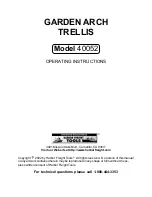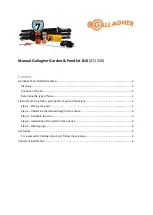
ENGLISH
GB
GB
LUBRICATING DRIVE SHAFT (*)
Once per season, the wedge on the drive shaft
should be greased. Remove the wheel (wheel cap,
screw and washer). Then remove the circlip and
washer so that the gear wheel can be removed
from the shaft. Lubricate the wedge with universal
grease.
Reinstall the wedge (the wedge is installed differ-
ently on the right and left side, fig. 12-13). Install
the gear wheel so that the «L» faces out on the left
side and the «R» faces out on the right side
(machine viewed from the rear).
BATTERY (*)
In normal use during the season, the battery is
charged by the engine. If the engine cannot be
started with the ignition key, it may be because the
battery is 'dead'.
Connect the battery charger (provided) to the bat-
tery, then connect the charger to a wall socket and
charge for 24 hours (fig. 14).
The battery charger may not be connected directly
to the engine terminal. It is not possible to start the
engine with the charger as the power source and
the charger could be damaged.
WINTER STORAGE
Remove the battery and store it fully charged (see
above) in a dry, cool place (between 0°C and
+15°C). At least once during the winter storage
period, the battery should be maintenance-
charged.
Before the start of the season, the battery should
be charged once again for 24 hours.
ADJUSTING CLUTCH CABLE (*)
Type I
If the drive does not engage when the clutch loop
is pressed against the handle, or if the lawnmower
feels cumbersome or slow, this may be because
the clutch in the transmission is slipping. To rectify
this situation, adjust the clutch cable as follows
(with the engine off):
1. When the clutch loop is released, it should be
possible to push the mower backwards without
any resistance. If this is not the case, screw in
the nipple
T
until the mower can be pushed (fig.
15).
2. When the clutch loop is pressed in approx. 2 cm
(position 1), there should be some resistance
when pushing the lawnmower. With the clutch
loop fully pressed in (position 2) it should not be
possible to push the mower. Unscrew the nipple
T
until this position is achieved.
Type II
Check the clutch function (fig. 16):
1. Push the mower forwards and backwards with
disengaged transmission.
2. Set the clutch control to the
position and
push the mower until the front wheels engage.
3. In this position, the spring
H
should be extend-
ed 6 mm from it’s unloaded position to provide
sufficient locking force in the transmission.
4. If the spring is not extended sufficiently, adjust
the wire nipple
I
at the handlebar.
5. First loosen the locking nut
S
and then adjust
the nipple
I
.
6. Set the clutch control to the
position and
check that the transmission is disengaged by
rolling the mower forwards and backwards.
ADJUSTING DRIVE BELT (*)
Check the belt tension regularly. The drive belt is
correctly adjusted when the shoulder bolt
K
is cen-
tred in the front hole on the engine bracket (fig. 17).
Incorrect belt tension can bring about abnormal
vibrations in the handle (the belt is tensioned too
tightly) or the belt can start to slide (the belt is not
tensioned enough).
Adjust the drive belt as follows (fig. 17):
Stop the engine and remove the spark plug cable
from the spark plug.
Dismantle the transmission casing. Undo the screw
L
. Pull the transmission forwards so that the belt is
tensioned and tighten the screw
L
.
The drive belt must be adjusted so that the shoul-
der bolt
K
is centred in the front hole on the engine
bracket.
SHOCK-ABSORBER
Fig. 18. Check the shock-absorber and the insulat-
ing sleeves twice per season. Replace in the event
of damage or wear.
CHANGING BLADES
To replace the blade, undo the screw (fig. 19-20).
Fit the new blade so that the stamped logo is
turned up facing the blade holder (not facing the
grass).
35


























